PONTIAC PONTIAC 1997 Owners Manual
Manufacturer: PONTIAC, Model Year: 1997, Model line: PONTIAC, Model: PONTIAC PONTIAC 1997Pages: 419, PDF Size: 19.67 MB
Page 251 of 419
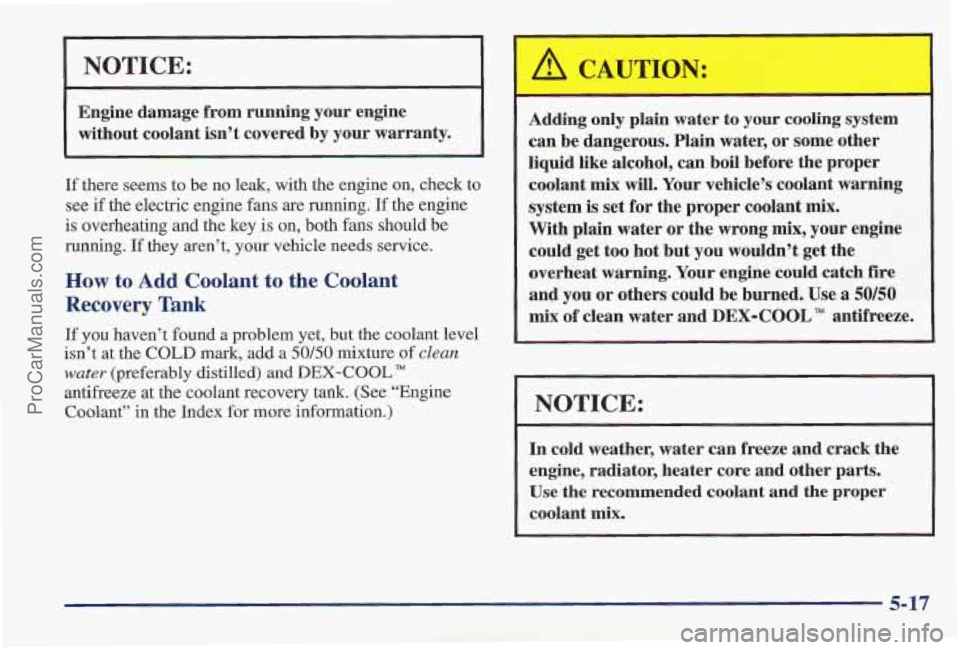
NOTICE:
Engine damage from running your engine
without coolant isn’t covered
by your warranty.
_I
If there seems to be no leak, with the engine on, check to
see if the electric engine fans are running.
If the engine
is overheating and the key
is on, both fans should be
running. If they aren’t, your vehicle needs service.
How to Add Coolant to the Coolant
Recovery Tank
If you haven’t found a problem yet, but the coolant level
isn’t at the
COLD mark, add a 50/50 mixture of clean
water (preferably distilled) and DEX-COOL
antifreeze at the coolant recovery tank. (See “Engine
Coolant” in the Index for more information.)
Adding only plain water to your cooling system
can be dangerous. Plain water, or some other
liquid like alcohol, can boil before the proper
coolant mix will. Your vehicle’s coolant warning
system is set for the proper coolant
mix.
With plain water or the wrong mix, your engine
could get too hot but you wouldn’t get the
overheat warning. Your engine could catch
fire
and you or others could be burned. Use a 50/50
mix of clean water and DEX-COOL antifreeze.
I NOTICE:
In cold weather, water can freeze and crack the
engine, radiator, heater core and other parts.
Use the recommended coolant and the proper
coolant mix.
ProCarManuals.com
Page 252 of 419
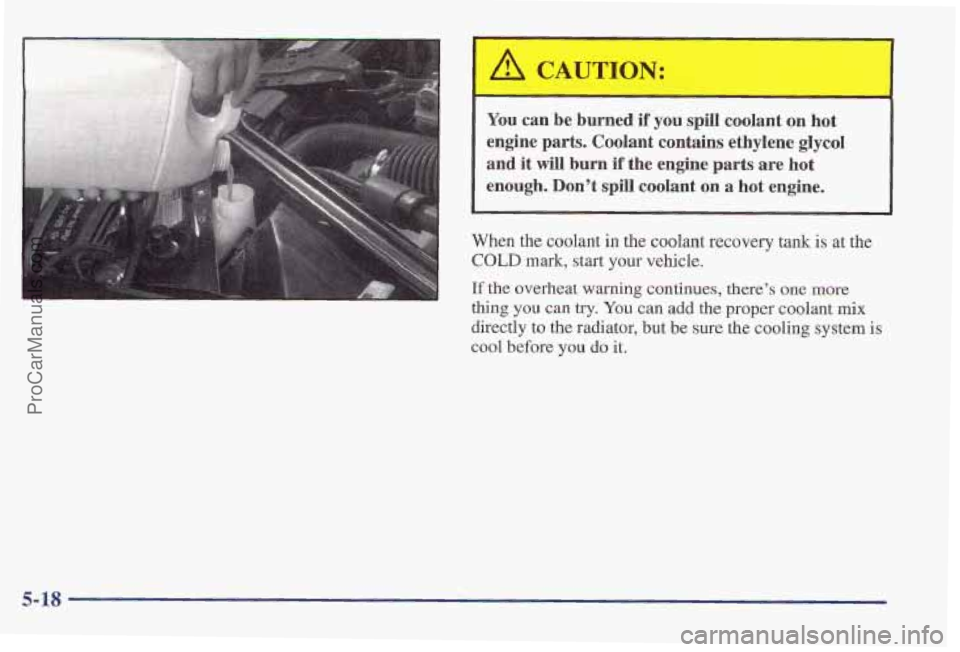
You can b’e burned if you spill coolant on hot
engine
parts. Coolant contains ethylene glycol
and
it will burn if the engine parts are hot
enough. Don’t spill coolant on a hot engine.
When the coolant in the coolant recovery tank is at the
COLD mark, start your vehicle,
If the overheat warning continues, there’s one more
thing you can try. You can add the proper coolant mix
directly to the radiator, but be sure the cooling system is
cool before you do it.
5-18
ProCarManuals.com
Page 253 of 419
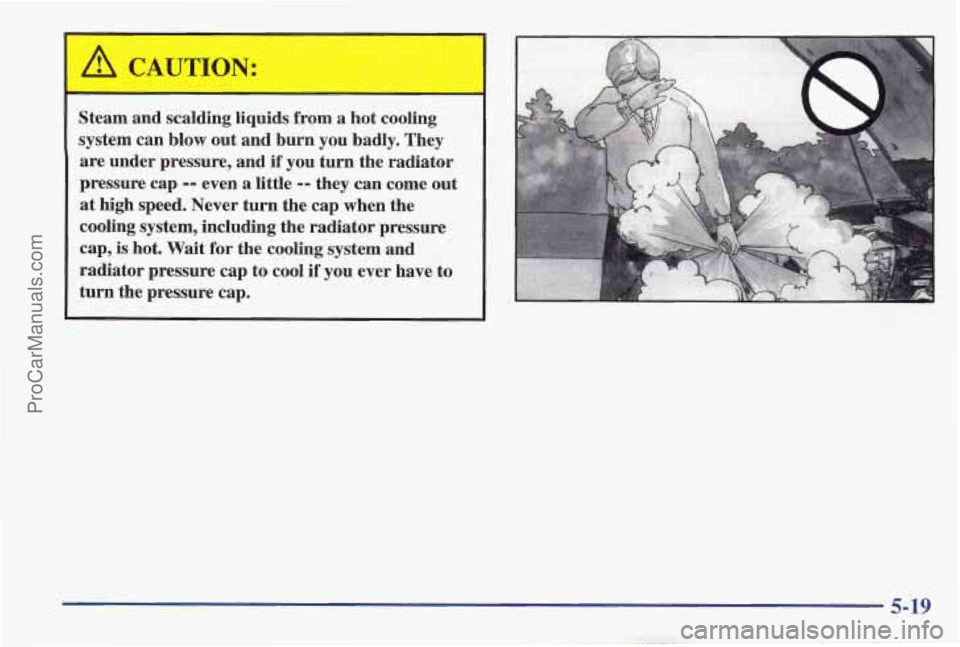
Steam and scalding liquids from a hot cooling
system can blow out and burn you badly. They
are under pressure, and
if you turn the radiator
pressure cap
-- even a little -- they can come out
at high speed. Never turn the cap when the
cooling system, including the radiator pressure
cap,
is hot. Wait for the cooling system and
radiator pressure cap
to cool if you ever have to
turn the pressure cap.
--:. 5-19
-. . . .. .. .A , ProCarManuals.com
Page 254 of 419
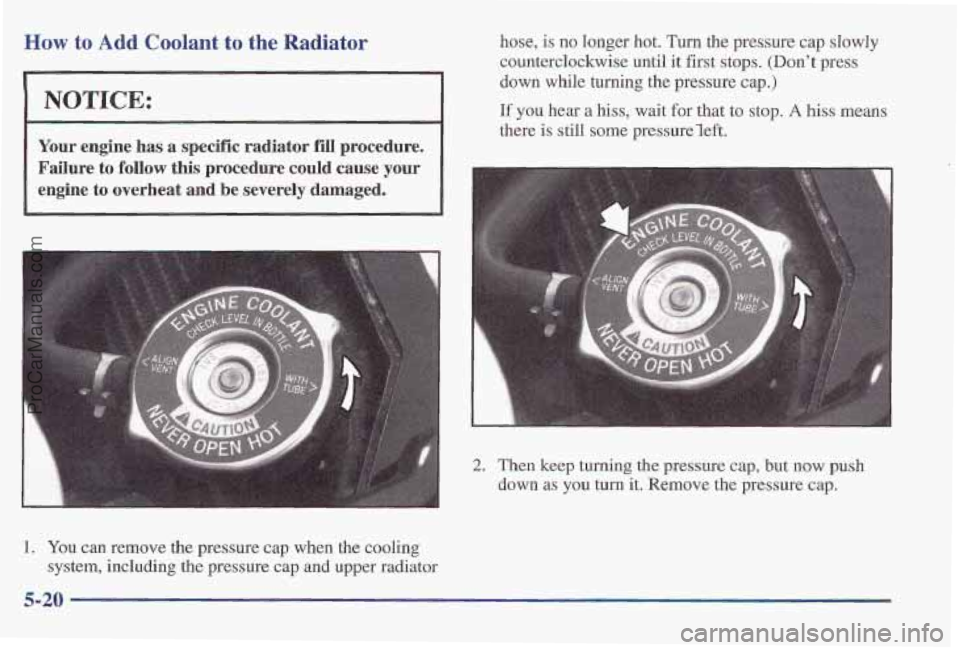
How to Add Coolant to the Radiator
NOTICE:
Your engine has a specific radiator fill procedure.
Failure to
follow this procedure could cause your
engine to overheat
and be severely damaged.
hose, is no longer hot. Turn the pressure cap slowly
counterclockwise until
it first stops, (Don’t press
down while turning the pressure cap.)
If you hear a hiss, wait for that to stop. A hiss means
there
is still some pressureleft.
2. Then keep turning the pressure cap, but now push
down
as you turn it. Remove the pressure cap.
1. You can remove the pressure cap when the cooling
system, including the pressure
cap and upper radiator
5-20
ProCarManuals.com
Page 255 of 419
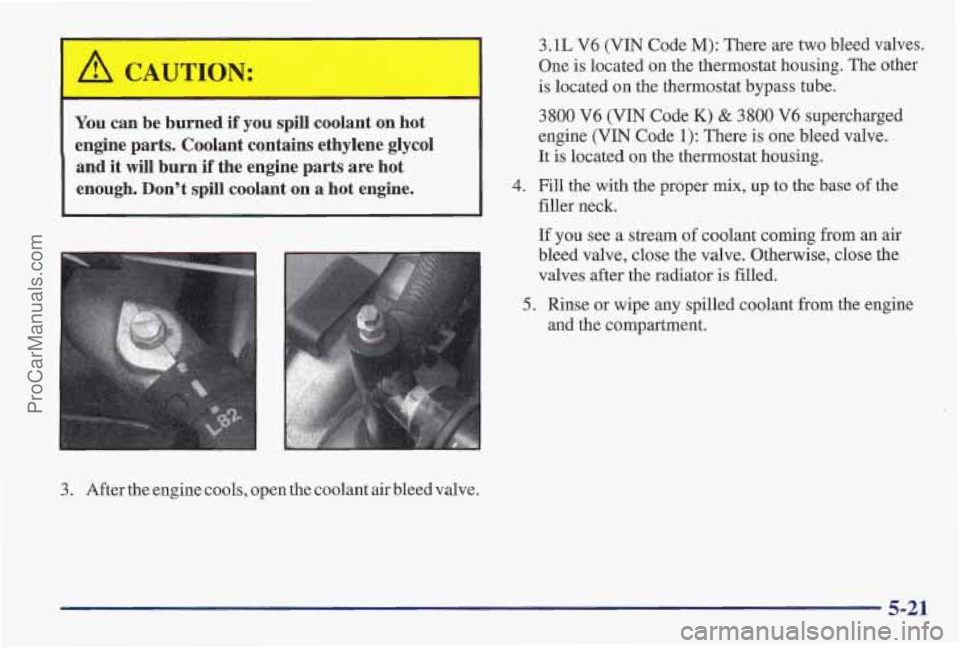
[ON:
You can be burned if you spill coolant on hot
engine parts. Coolant contains ethylene glycol and it will burn if the engine parts are hot
enough. Don't spill coolant on a hot engine.
3. After the engine cools, open the coolant air bleed valve. 3.1L
V6 (VIN Code
M): There are two bleed valves.
One is located on the thermostat housing. The other
is located on the thermostat bypass tube.
3800 V6 (VIN Code
K) & 3800 V6' supercharged
engine (VIN Code
1): There is one bleed valve.
It is located on the thermostat housing.
4. Fill the with the proper mix, up to the base of the
filler neck.
If you see
a stream of coolant coming from an air
bleed valve, close the valve. Otherwise, close the
valves after the radiator
is filled.
5. Rinse or wipe any spilled coolant from the engine
and the compartment.
5-21
ProCarManuals.com
Page 256 of 419
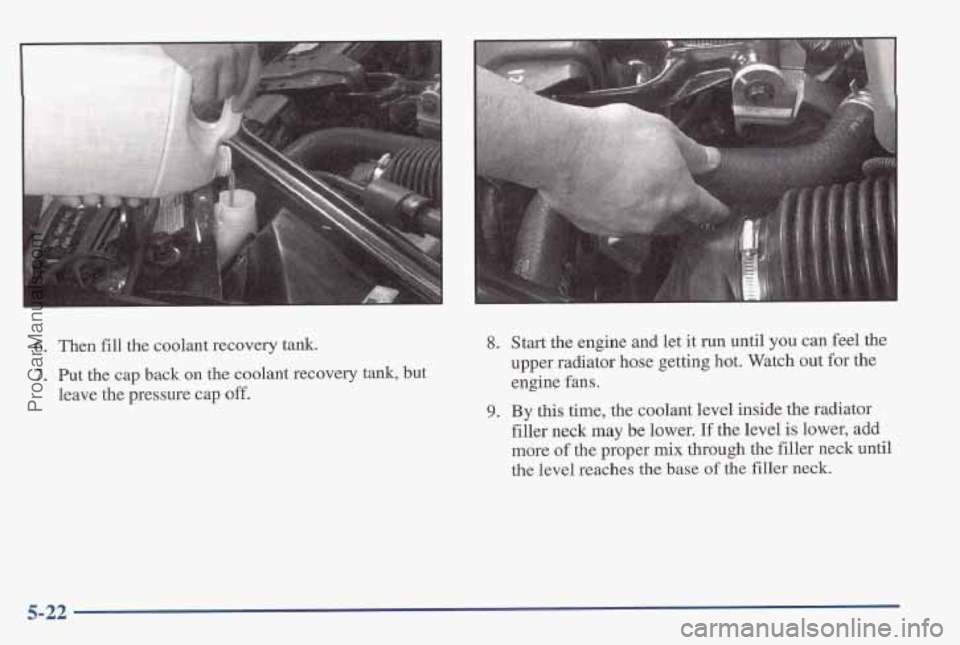
6. Then fill the coolant recovery tank.
7. Put the cap back on the coolant recovery tank, but
leave the pressure cap
off.
8. Start the engine and let it run until you can feel the
upper radiator
hose getting hot. Watch out for the
engine fans,
9, By this time, the coolant level inside the radiator
filler
neck may be lower. If the level is lower, add
more
of the proper mix through the filler neck until
the level reaches the base of the filler neck.
5-22
ProCarManuals.com
Page 257 of 419
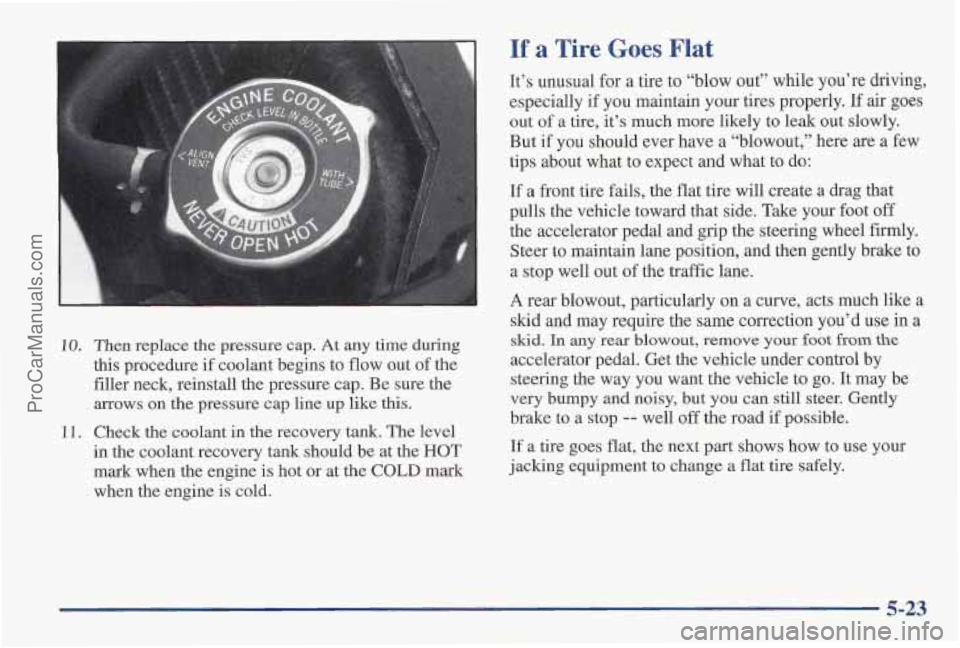
If a Tire Goes Flat
10. Then replace the pressure cap. At any time during
this procedure if coolant begins to flow out
of the
filler neck, reinstall the pressure cap. Be sure the
mows
on the pressure cap line up like this.
11. Check the coolant in the recovery tank. The level
in the coolant recovery tank should be at the HOT
mark when the engine is
hot or at the COLD mark
when the engine is cold. It’s unusual for
a tire to “blow out”
while you’re driving,
especially
if you maintain your tires properly. If air goes
out of a tire, it’s much more likely to leak out slowly.
But if you should ever have a “blowout,” here are a few
tips about what to expect and what to do:
If
a front tire fails, the flat tire will create a drag that
pulls the vehicle toward that side. Take your foot
off
the accelerator pedal and grip the steering wheel firmly.
Steer to maintain lane position, and then gently brake to
a stop well out
of the traffic lane.
A rear blowout, particularly on a curve, acts much like a
slud and may require the same correction you’d use in a
skid. In any rear blowout, remove your foot from the
accelerator pedal. Get the vehicle under control by
steering the way you want the vehicle to go. It may be
very bumpy and
noisy, but you can still steer. Gently
brake to a stop
-- well off the road if possible.
If a tire goes flat, the next part shows how to use your
jacking equipment to change a
flat tire safely.
ProCarManuals.com
Page 258 of 419
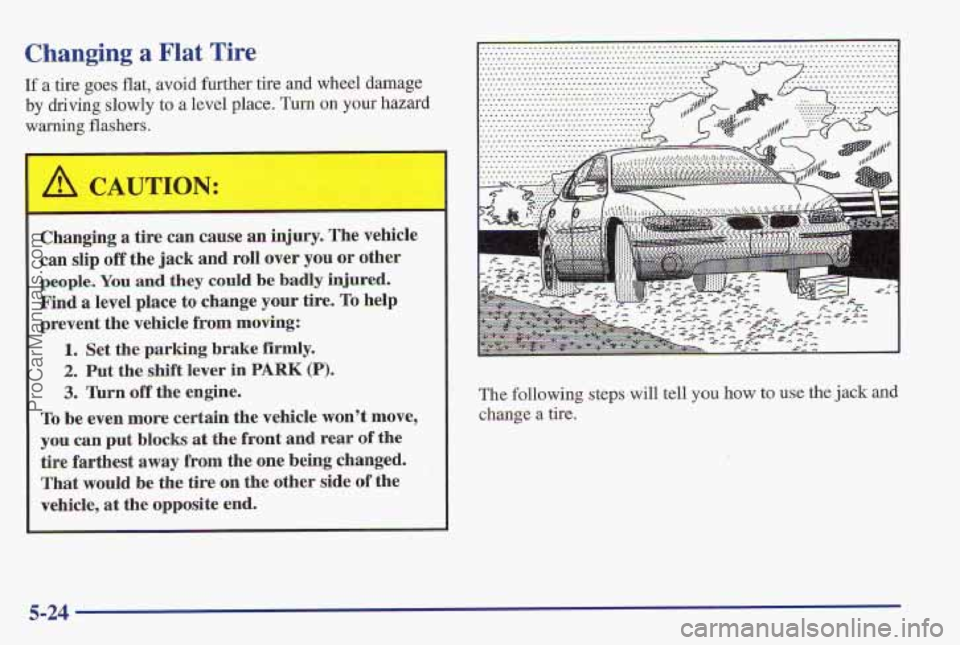
Changing a Flat Tire
If a tire goes flat, avoid further tire and wheel damage
by driving slowly to
a level place. Turn on your hazard
warning flashers,
Changing a tire can cause an Ijury. The vehicle
can slip off the jack and roll over you or other
people.
You and they could be badly injured.
Find
a level place to change your. tire. To help
prevent the vehicle
from moving:
1. Set the parking brake firmly.
2. Put the shift lever in PARK (P).
3. Turn off the engine.
To be even more certain the vehicle won’t move,
you can put blocks at the front and rear of the
tire farthest
away from the one being changed.
That
would be the tire on the other side of the
vehicle,
at the opposite end,
The following steps will tell you how to use the jack and
change
a tire.
5-24
ProCarManuals.com
Page 259 of 419
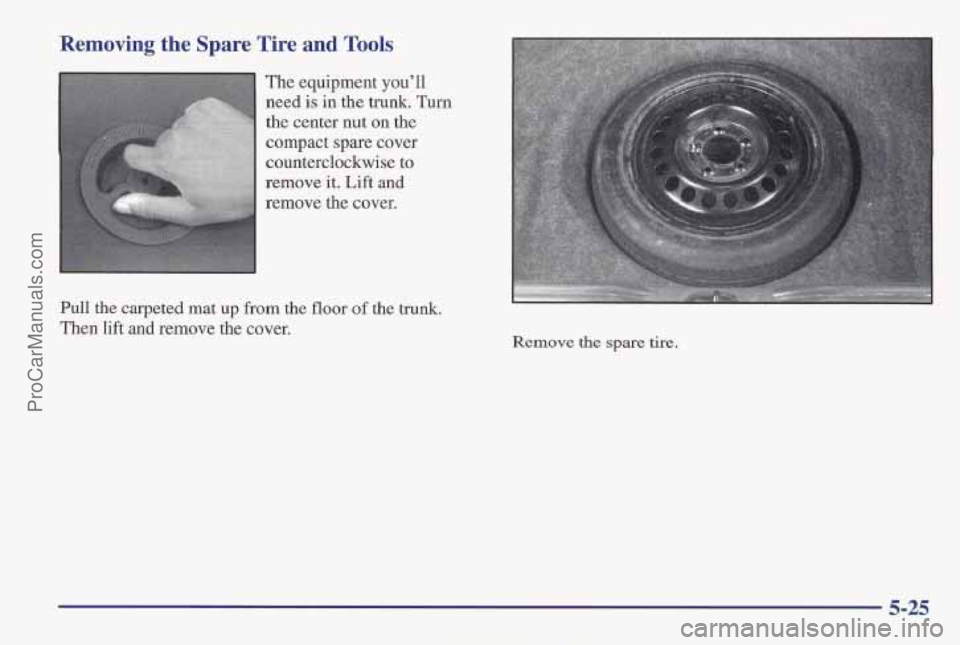
Removing the Spare Tire and Tools
I
The equipment you’ll
need
is in the trunk. Turn
the center nut on the
compact spare cover
counterclockwise to
remove
it. Lift and
remove the cover.
Pull the carpeted mat up from the floor of the trunk.
Then lift and remove the cover. Remove the
spare tire.
5-25
ProCarManuals.com
Page 260 of 419
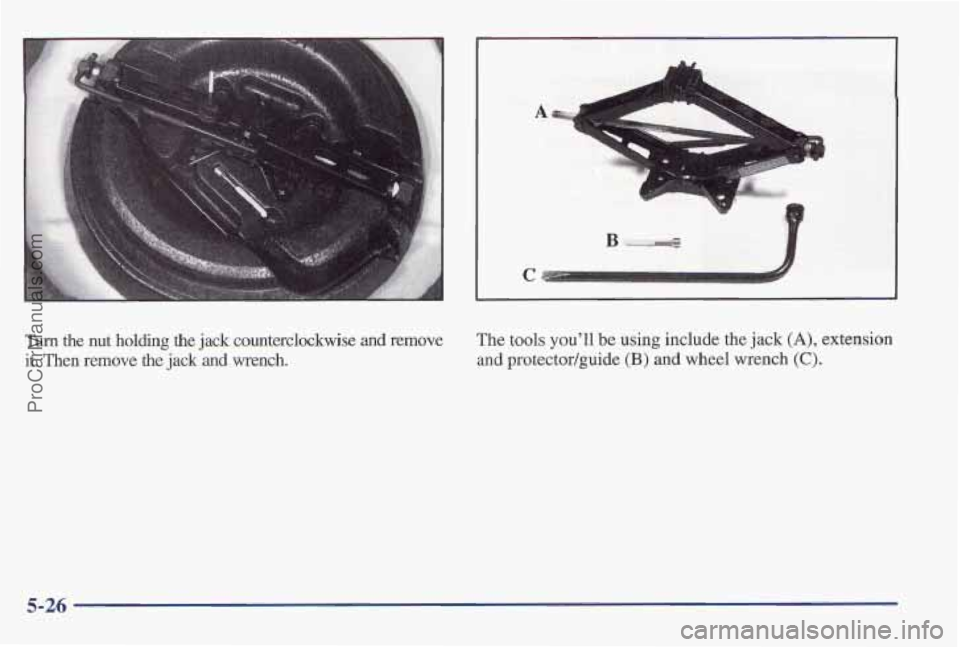
Turn the nut holding the jack counterclockwise and remove
it. Then remove
the jack and wrench. The tools you'll
be using include the
jack (A), extension
and protectodguide
(B) and wheel wrench (C).
5-26
ProCarManuals.com